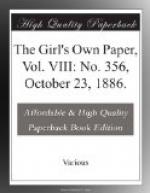In order to make a contrast between the design and the background, you can dot or line over the slab upon which the design is lying, so as to make the surface rough in texture. When the clay is quite dry, which will take some week or more to effect, you can put any further work into the design with the steel tool, which must be used to scrape the clay; for if you exert any pressure upon the dry clay it very soon chips, and it is almost impossible to repair such damage, and for this reason: that if you stick on a piece of wet clay to the dry clay, the moisture of the wet clay is soon absorbed by the dry, and the piece stuck on immediately falls off. The only chance is to keep damping the part damaged until the clay all round gets quite moist again, and you must then model another piece on to the broken part. Dry your work very slowly at first, to prevent it cracking or warping, and when it seems quite hard put it into a warmer place, for, though clay may appear hard on the surface, there is sure to be a good deal of moisture inside, especially if the clay be thick, and should it be put into a kiln before the moisture is entirely evaporated, the modelled clay will fly into minute fragments, and cause incalculable damage to other work in the kiln. I recommend my readers to put their work into a hot oven two or three times after it has been drying for two or three weeks, so as to insure the clay being quite hard. I lost several works through firing them before they were dry enough.[2]
The heat that china is put to fix the colours is not sufficient for baking clay, and it must be sent to some place where underglaze pottery is fired. This first firing turns the clay into “biscuit,” and if any painting is to be done on it, now is the time to do it. Underglaze or Barbotine colours should be used, and they should be put on in thin washes. The whole work must then be glazed and fired. But I shall not touch further on this part of the subject here, for I must say something about modelled decoration applied to vases and plaques.
The plaque or vase to receive modelled decoration must be of the same degree of dampness, or nearly the same degree of dampness, as the clay used in modelling, for reasons already stated. You cannot put modelled decoration on to clay that is dry, or ware that has been fired. To make a plaque, it is almost necessary to have a plaster mould. You might make this for yourself by buying a china plaque the shape and size you require, and filling this plaque with plaster-of-Paris, being careful to let the plaster come to edge of plaque all round. When the plaster is dry, trim the edge round, and take it out of plaque. You must now roll out a flat sheet of clay sufficiently large to cover this plaster mould, and, by pressing the clay evenly all over the mould, and trimming round the edges with a knife, you will get a clay plaque sufficiently good to answer your purpose. Don’t attempt to remove the clay immediately from the plaster, but let it remain on a few hours, to enable the clay to set. The surface of this plaque may be kept moist by keeping a damp flannel over it. When the modelling has been started, the damp cloth must not press upon the modelled portions, but be supported on a wicker frame.




